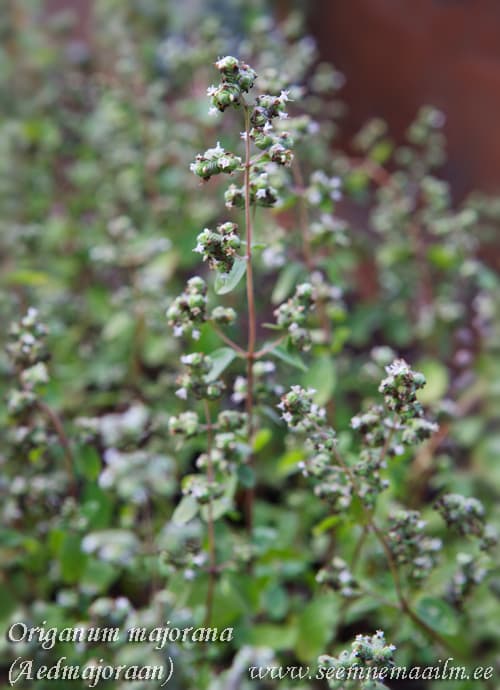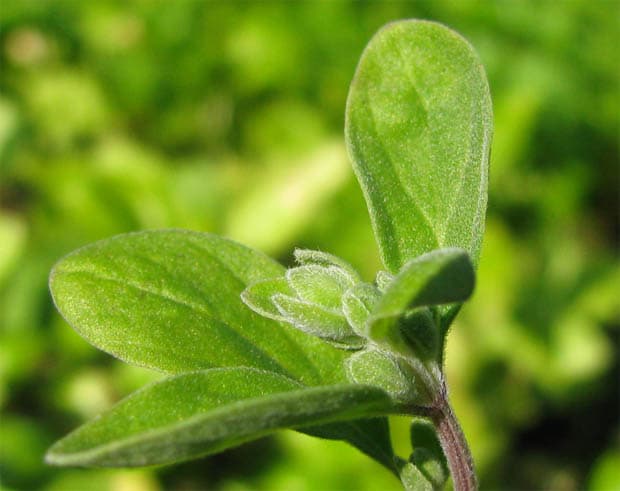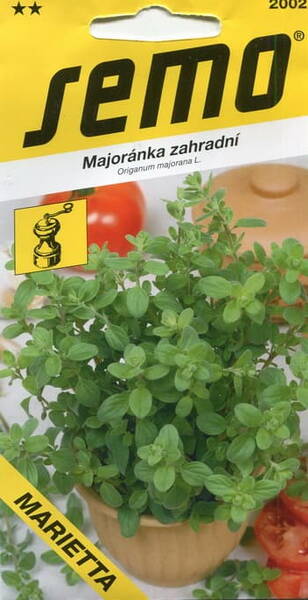The joy and pride of the gardener!
An annual, highly branched subshrub. All parts of the plant have a pleasant spicy aroma and taste. Good honey plant.
Contains essential oil and tannins. Young shoots with leaves and inflorescences are used both fresh and dried in cooking and canning.
Meat and vegetable dishes, homemade sausages and sauces with marjoram are not only tastier but also better digestible. Grown on light, nutrient-rich soils. Marjoram is thermophilic, at early stages of development it is sensitive to frosts.
In the south, it is grown in open ground, in the middle lane and in northern regions - through seedlings. In the latter case, the seeds are sown in early April (0.1 g per 200 plants). Marjoram seeds are very small, they do not require embedding and it is enough to roll them. Seedlings appear on the 20-23rd day. Seedlings are planted in the ground after the end of frost, according to the scheme 20ґ by 25 cm. Care consists in loosening row spacing and weeding.
Marjoram is harvested before flowering. The plant is cut about 6 cm from the ground, then it shoots again, and a second rich harvest is ready by autumn.
Harvesting begins during the flowering period, cutting off shoots at a height of 5-6 cm from the ground.
Dried plants can be stored in closed containers for several years without losing their beneficial properties.
1.0 g = 2000-4000 seeds.


Eng.: Sweet marjoram, knotted marjoram. Suom.: Maustemeirami, meirami. Sven.: Mejram, kloka gumman, sluga gubbem. Bot. syn.: Majorana hortensis Moench, Majorana majorana L., Origanum majoranoides Willd.
* In the Middle Ages, marjoram was grown for its aroma and beauty. Before people got acquainted with the valuable qualities of hops, marjoram was used instead of it in brewing, and in France - in winemaking. It was also added to the water for washing hands during solemn meals.
Today, marjoram as a spice is used very widely: added to soups, sauces for stews, put in sausages, minced meats and pates. Marjoram leaves and flowers contain up to 0.4% essential oil. Young shoots are rich in rutin (127 mg%), ascorbic acid (up to 44 mg%) and carotene (up to 5.5 mg%).
As a medicinal plant, marjoram has a diuretic property, improves digestion, and also has a beneficial effect on neuroses. Stimulates the activity of the stomach and intestines. In the form of tinctures and decoctions, it is used for whooping cough, cough, insomnia, migraine, colic in children, and diseases of the gums and teeth.
* Basically, the aerial part of the plant is used, since it is it contains aromatic essential oils, pectins, enzymes, vitamins and tannins.
Marjoram improves digestion and enhances the formation of gastric juice and bile.
The herb infusion has antispasmodic, antiseptic, diuretic, tonic and antiscorbutic effects.
It is prescribed for gastritis with low acidity of gastric juice, chronic cholecystitis and enterocolitis, flatulence, as well as headaches, insomnia, menstrual disorders, vomiting and gastrointestinal colic.
In folk medicine, marjoram is used as a gastric, tonic, anticatarrhal and wound healing agent.
Marjoram in collections with other medicinal plants is used for paralysis, neurasthenia, bronchial asthma and runny nose.
It is used as an infusion internally and externally for baths and lotions on wounds.
Crushed fresh grass is applied overnight to inflamed corns.
• 4 teaspoons of crushed raw materials per 1 cup of boiling water, leave for 15-20 minutes, strain.
Take 1/4 cup 4 times a day 15-20 minutes before meals with bloating.












